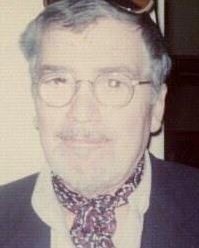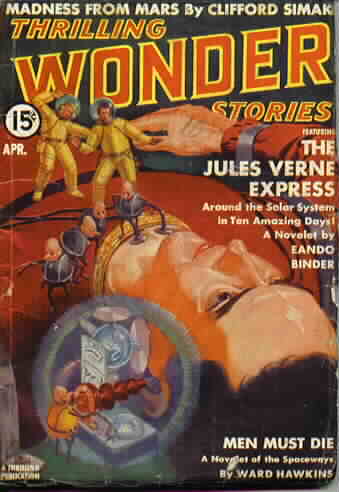 Alfred Bester (1913-1987) was named a Science Fiction and Fantasy Writers of America Grand Master in 1987 as he lay on his deathbed. He penned two of the most revered novels–both considered classics–in science fiction history, The Demolished Man (1953, for which he won the first Hugo), and The Stars My Destination (original title, Tiger! Tiger!, 1957). Both were first serialized in Galaxy magazine before appearing in book form. During the 1940’s and 1950’s Bester would write some of the most imaginative and well-regarded short stories in the genre, stories still talked about to this day whenever fans and critics gather. The photo at right was taken at the 1976 World Science Fiction Convention in Kansas City, Missouri, where I had the good fortune of spending an entire afternoon (in a bar) imbibing adult beverages and interviewing the gracious, and most vivacious, Mr. Bester.
Alfred Bester (1913-1987) was named a Science Fiction and Fantasy Writers of America Grand Master in 1987 as he lay on his deathbed. He penned two of the most revered novels–both considered classics–in science fiction history, The Demolished Man (1953, for which he won the first Hugo), and The Stars My Destination (original title, Tiger! Tiger!, 1957). Both were first serialized in Galaxy magazine before appearing in book form. During the 1940’s and 1950’s Bester would write some of the most imaginative and well-regarded short stories in the genre, stories still talked about to this day whenever fans and critics gather. The photo at right was taken at the 1976 World Science Fiction Convention in Kansas City, Missouri, where I had the good fortune of spending an entire afternoon (in a bar) imbibing adult beverages and interviewing the gracious, and most vivacious, Mr. Bester.
 His first SF story (“The Broken Axiom”) appeared in the April, 1939 issue of Thrilling Wonder Stories (cover at left). After selling to Astounding Science Fiction for a few years, Bester was enticed to write for comic books and penned numerous issues of DC’s Superman, Green Lantern, and others. Less well known is that in 1944 he turned to writing for radio. He would pen scripts for The CBS Radio Mystery Theater, Nick Carter (Master Detective), Nero Wolfe, Charlie Chan, and of most interest to us here…The Shadow. Bester wrote (as closely as we have been able to determine) nine Shadow episodes for the 1944-45 season, which ran from September of 1944 through April of 1945 (John Archer played The Shadow at this juncture, and would later go on to star in the film of Robert A. Heinlein’s novel Destination Moon). Of these nine shows, six are acknowledged as “lost.”
His first SF story (“The Broken Axiom”) appeared in the April, 1939 issue of Thrilling Wonder Stories (cover at left). After selling to Astounding Science Fiction for a few years, Bester was enticed to write for comic books and penned numerous issues of DC’s Superman, Green Lantern, and others. Less well known is that in 1944 he turned to writing for radio. He would pen scripts for The CBS Radio Mystery Theater, Nick Carter (Master Detective), Nero Wolfe, Charlie Chan, and of most interest to us here…The Shadow. Bester wrote (as closely as we have been able to determine) nine Shadow episodes for the 1944-45 season, which ran from September of 1944 through April of 1945 (John Archer played The Shadow at this juncture, and would later go on to star in the film of Robert A. Heinlein’s novel Destination Moon). Of these nine shows, six are acknowledged as “lost.”
Here we treat you to the surviving trio of Alfred Bester’s Shadow episodes. “The Brief Fame of John Copper” aired on March 11, 1945 and Bester’s concept is, to say the least, clever. Lamont Cranston is framed for murder and thrown in jail, while The Shadow is called upon to prove his guilt. Quite a conundrum for sure, especially when Cranston’s fingerprints are found on the murder weapon and he is found unconscious next to the victim. And as we all know, Lamont Cranston is The Shadow! Leave it to Alfred Bester to come up with a puzzler like this! (I have also learned, via correspondence with the world’s foremost expert on The Shadow, Anthony Tollin, that “The Brief Fame of John Copper” exists only in the Australian rebroadcast, and features Lloyd Lambel as Lamont Cranston. So this episode is an even rarer treat than I had supposed. Thank you, Anthony Tollin, for sharing your expertise in this matter.)
“The Destroyer” aired on March 25, 1945. It deals with a psychotic terrorist who has blown up several buildings around the city and now threatens to destroy the entire city by noon. What does this mad terrorist want? What are his demands? The answer: he wants and demands nothing. He has simply come to the conclusion that history remembers Destroyers more than it does Creators and wants desperately to be remembered. It is up to The Shadow to piece together the clues and stop this madman before the deadline comes to pass.
(Sandwiched between the episode above and the one below we note that the April 1, 1945 episode, “The Sword of Dengri-La” was written by none other than the late SF author Bob Shaw. Sadly, as with most of the Bester-penned episodes, it is considered lost.)
“The Little Man Who Wasn’t There” aired on April 8, 1945. It involves a series of daring, expensive thefts of items right off the victims’ persons, and in public, but no one can spot the “invisible” thief. The police, of course, suspect The Shadow because of his well-known ability to “appear” invisible–though Shadow fans know it is only his Orient-acquired ability to “cloud men’s minds” so that they cannot see him, and thus he is not, in a strict sense, truly invisible. Nevertheless, The Shadow must outwit another with invisibility powers (perhaps greater than his own!), apprehend this wily thief, unravel the mystery and restore the stolen property…and all while the police are on his trail.
As in many of The Shadow’s adventures, it is the psychological impact of his invisibility and eerie, disembodied voice that rattles criminals and evil-doers into committing their fatal mistake(s). For a more detailed examination of the origin of The Shadow on radio, see “Death House Rescue” (starring Orson Welles) presented elsewhere here.
Please note that the latter pair of episodes are of less than perfect quality (as are many old time radio shows in general, unless they have been expensively digitally remastered). That said, and primarily because they were written by Alfred Bester, we are happy to be able to share them with you.
“The Brief Fame of John Copper” – March 11, 1945
Play Time: 28:53
“The Destroyer” – March 25, 1945
Play Time: 28:38
“The Little Man Who Wasn’t There” – April 8, 1945
Play Time: 29:41